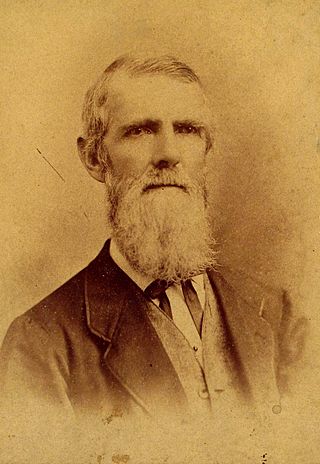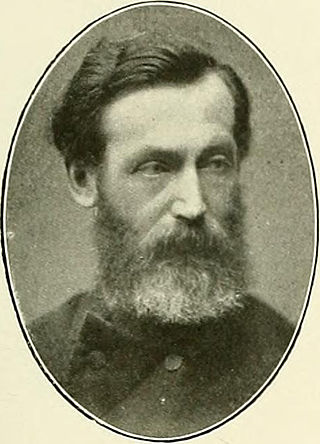
Miles Joseph Berkeley was an English cryptogamist and clergyman, and one of the founders of the science of plant pathology. The standard author abbreviation Berk. is used to indicate this person as the author when citing a botanical name.

Johann Müller was a Swiss botanist who was a specialist in lichens. He published under the name Johannes Müller Argoviensis to distinguish himself from other naturalists with similar names.

Henry William Ravenel was an American planter and botanist. He studied fungi and cryptogams in South Carolina, discovering a large number of new species. The genus Ravenelia is named after him, along with many of the species he discovered.

Mordecai Cubitt Cooke was an English botanist and mycologist who was, at various points, a London schoolteacher, a Kew mycologist, curator at the India Museum, journalist and author. Cooke was the elder brother of the art-education reformer Ebenezer Cooke (1837–1913) and father of the book illustrator and watercolour painter William Cubitt Cooke (1866–1951).
Christian Friedrich Ecklon was a Danish botanical collector and apothecary. Ecklon is especially known for being an avid collector and researcher of plants in South Africa.

Karl Wilhelm Gottlieb Leopold Fuckel was a German botanist who worked largely on fungi.
Philip Burnard Ayres (1813–1863) was a British physician, botanist and plant collector. He was born at Thame in Oxfordshire on 12 December 1813. He initially began to collect plants in his native United Kingdom and also in France. Between 1841 and 1845 he issued three exsiccata-like series, among them Mycologia Britannica or specimens of British fungi and with William Baxter another exsiccata under the title Flora Thamnensis. In 1856 Ayres was appointed by Queen Victoria to superintendency of quarantine on Flat Island, Mauritius under governor Robert Townsend Farquhar. Ayres is particularly well known for his extensive plant collections made while in this position. He is also credited for finding the first sub fossil remains of the dodo in 1860. From 1856 to 1863 he traveled through Madagascar, the Seychelles, and the Mascarenes to develop this rich collection of Indian Ocean plant specimens. These specimens are now in the herbaria collections of the Natural History Museum, London, the Royal Botanic Garden Edinburgh, the Royal Botanic Gardens, Kew, the Missouri Botanical Garden and the Muséum National d'Histoire Naturelle, Paris. In addition to collecting, Ayres catalogued and sketched the plants in the wild, as was common among nineteenth century naturalists. He also planned to write a book about the flora of Mauritius, but he died from relapsing fever in his home in Port Louis on 30 April 1863 before the flora could be accomplished. Ayres' wife Harriet collected his written records and bequeathed them to the Royal Botanic Gardens, Kew.

George Samuel Perrottet, also known as Georges Guerrard-Samuel Perrottet, was a botanist and horticulturalist from Praz, in the commune of Vully-le-Bas, today Mont-Vully, Switzerland. After expeditions in Africa and Southeast Asia where he collected plant and animal specimens, he worked in French Pondicherry, India, where he established a botanical garden. He took a special interest in plants of economic importance and was involved in the activities of acclimatisation societies in the various colonies of France. Many of his zoological specimens, sent to museums in France, were examined by other naturalists and named after him.

Ferdinand Christian Gustav Arnold was a German lichenologist and taxonomist born in Ansbach, Bavaria. Even as a high school student he showed an active interest in botany: "Ich und August Gattinger ... durchstreiften von November 1846 bis zum Spätherbst 1847, Pflanzen sammelnd, die Landschaft von München nach allen Richtungen.".

Job Bicknell Ellis was a pioneering North American mycologist known for his study of ascomycetes, especially the grouping of fungi called the Pyrenomycetes. Born and raised in New York, he worked as a teacher and farmer before developing an interest in mycology. He collected specimens extensively, and together with his wife, prepared 200,000 sets of dried fungal samples that were sent out to subscribers in series between 1878 and 1894. Together with colleagues William A. Kellerman and Benjamin Matlack Everhart, he founded the Journal of Mycology in 1885, forerunner to the modern journal Mycologia. He described over 4000 species of fungi, and his collection of over 100,000 specimens is currently housed at the herbarium of the New York Botanical Gardens. Ellis had over 100 taxa of fungi named in his honor.

Alexander Zahlbruckner was an Austrian-Hungarian botanist who specialized in the study of lichens. Johann Babtist Zahlbruckner, an earlier Austrian botanist, was his grandfather.

Gaspard Joseph Benedict Balansa, also known as Benjamin Balansa or Benedict Balansa, was a French botanist.

Josef Franz Freyn was an Austrian civil engineer and botanist.
Victor Félix Schiffner was an Austrian bryologist specializing in the study of hepatics.

Harald Lindberg was a Finnish botanist of Swedish parentage. He was the son of botanist Sextus Otto Lindberg (1835–1889).
Adriano Fiori was an Italian botanist.
Josef Nádvorník was a Czech lichenologist. He was an authority on lichens of the order Caliciales and, in particular, the genus Physcia.

Veli Johannes Paavo Bartholomeus Räsänen was a Finnish lichenologist.

Exsiccata is a work with "published, uniform, numbered set[s] of preserved specimens distributed with printed labels". Typically, exsiccatae are numbered collections of dried herbarium specimens or preserved biological samples published in several duplicate sets with a common theme or title, such as Lichenes Helvetici. Exsiccatae are regarded as scientific contributions of the editor(s) with characteristics from the library world and features from the herbarium world. Exsiccatae works represent a special method of scholarly communication. The text in the printed matters/published booklets is basically a list of labels (schedae) with information on each single numbered exsiccatal unit. Extensions of the concept occur.
William Mudd compiled the first flora of the lichens of the British Isles, in 1861. He was curator of Cambridge Botanic Garden 1n 1864.















